Challenges in New Product Development: Early Mistakes to Avoid
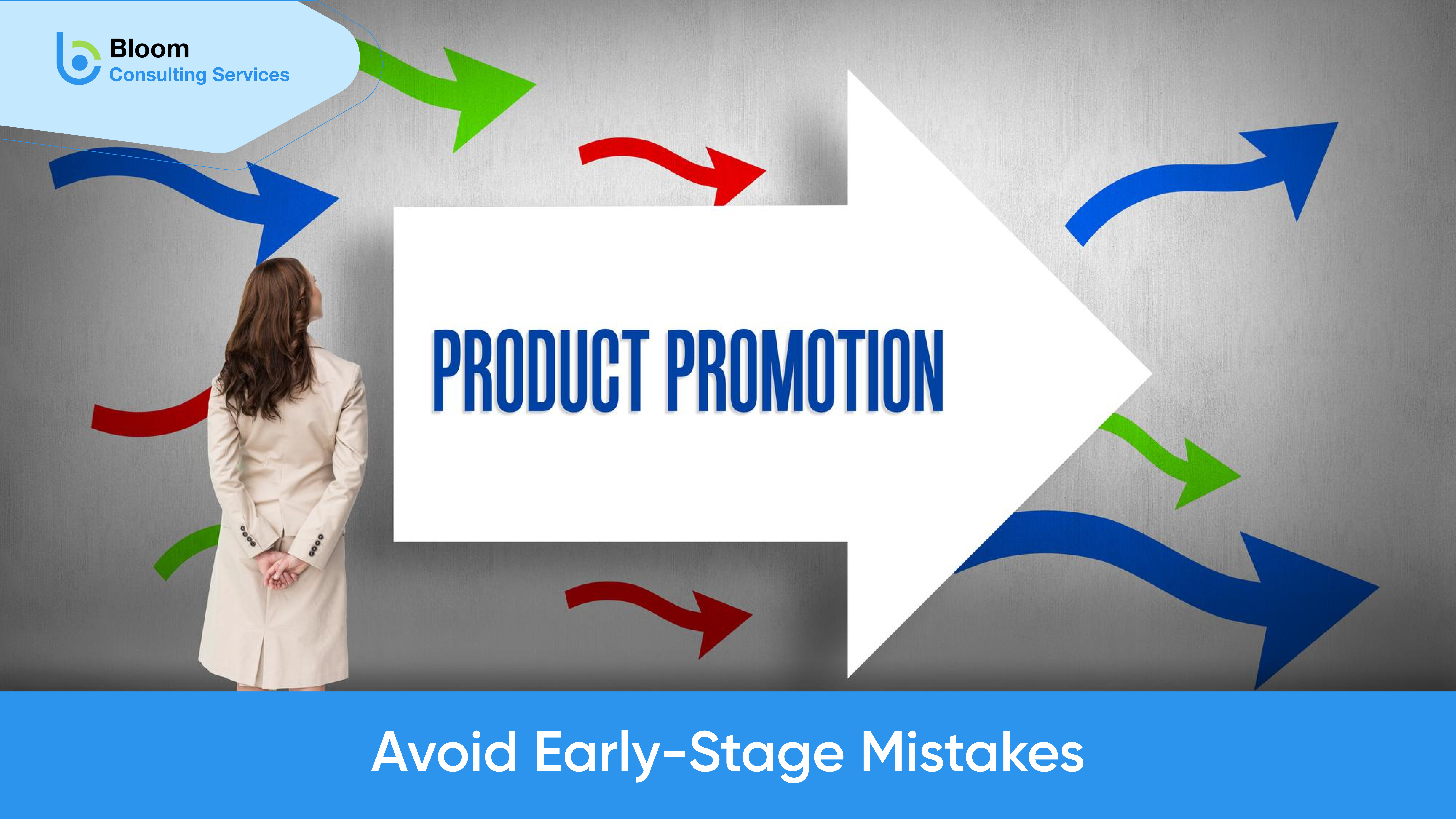
Developing a product and finally bringing it to life is never easy. Today, companies all grapple with one of the most common challenges in new product development; how to create something that is valued, usable, and challenged by fast markets. The design would turn ruthless with so much competition around, vacuum changes in customer needs, and scarce resources.
At the outset, lots of key decisions have to be made about product development. Teams have to decide what customers want, how to design a great product, how to build it right on time, and how to launch it the way it should be. Add new technologies and trends to this, and the problem just gets trickier.
Some companies do get it right, though. So, what’s theirs? Offers an insight: they avoid the pitfalls found in the first two steps, remain nimble and cooperative, and often seek expert end-to-end product development to assist them further. Teams working with the proper tools and mindset on all the challenges in new product development can accelerate their pace, work smartly, and work confidently.
Table of Contents
What is Product Development?
Product development involves the end-to-end journey of building and refining products, starting from concept generation to launch and beyond. It covers every stage, such as the validation of ideas, design, engineering, testing, and marketing, whether for a totally new offering or for improving an existing solution to cater to customer needs and deliver value.
Why Does it Matter?
Product development stimulates growth and innovation within a business. They also improve the opportunity for companies to stay competitive and relevant by adjusting customer expectations. With better product development, they find ways to bring new value, capture a wider share of the market, and build a presence for their brand.
Market-Related Challenges in Product Development
Generally, the most significant challenges in new product development lie outside your organization. Even so, many potential ideas fall to the bottom of the barrel if understanding the market, customer needs, competitors’ moves, trend shifts, and communication of value are considered. These external market issues represent an additional layer of complexity for new product developments. When unaddressed early on, organizations usually waste months or even years building something wrong- the wrong thing at the wrong time for the wrong audience.
Let’s analyze the most significant pitfalls of market misunderstanding and how companies in the real world negotiate them.
| Challenge | Core Issue | Example | Key Solution |
| Market Uncertainty | Markets shift rapidly, making static planning risky. | Hotels.com halted projects during COVID-19. | Use real-time data and stay adaptable. |
| Intense Competition | Rushing to market can compromise product quality. | Startups release weak MVPs under pressure. | Balance speed with quality through rapid but structured iterations. |
| Customer Misunderstanding | Misjudging needs leads to building the wrong product. | Airbnb validated deeply, others don’t. | Embed continuous user research early and often. |
| Pricing Pressures | Incorrect pricing hurts perception and profits. | Common in B2B with no pricing benchmarks. | Test multiple models and understand perceived value. |
| Lack of Marketing | Great products fail if no one hears about them. | Many teams ignore marketing until too late. | Start messaging and promotion early in development. |
| Research Errors | Bad data or biased feedback misguides teams. | Teams validate assumptions instead of testing them. | Use diverse methods and challenge assumptions regularly. |
| Weak Product-Market Fit | Functional products don’t resonate with users. | Superhuman refined via usage data and feedback. | Track retention and satisfaction; iterate to fit real needs. |
Start Your Product Development Journey
Market Uncertainty
Market conditions keep changing with time, causing multiple challenges in new product development. Consumer preferences keep evolving, new platforms arise, and a global event could turn demand around overnight! Any product developed with static data or based on some outdated assumption surely faces a risk of product launch mistakes.
Case Study: Hotels.com
The COVID-19 pandemic devastated the travel industry, and Hotels.com was hit severely. On account of the demand going down all of a sudden, the company cancelled a few product development initiatives. Despite months of planning and investment, the external market proved the single most significant roadblock, proving how even well-researched products could be turned upside down if lacking in adaptability.
Solution:
Keep agile forecasting and real-time data-enabled decision-making processes working in harmony with one another. Monitor competitor moves and bigger industry trends to course-correct well in time. Adaptability in how you develop products is mandatory if you are going to take on the unexpected.
Intense Competition
Global markets are crowded. For most categories, you’re rarely the only player building a solution. This intense competition drives the need to launch quickly, but rushing often leads to overlooking key validation steps, testing, or designing. This trade-off between speed and quality is one of the recurring challenges in new product development.
There is always another team rushing to the finish line with a similar goal, be it a fitness app or some new fintech tool. Startups keep making common mistakes in product development: rushing to release a half-baked MVP that can barely hold up before competitive companies with better execution finish on top.
Solution: Speed and Quality Take Precedence
Shortening iteration cycles should be important. That means leveraging rapid prototyping along with continuous feedback loops to ensure the task follows through really fast. Building momentum means efficient, not skipping steps.
Understanding and Meeting Customer Needs
It sounds easy, but building something people really want is among the most complicated steps. Solving the wrong problems or solving the correct problems wrongly kills many product journeys silently. The most common disruption is found among new product challenges.
Case Study: Airbnb
Airbnb came up with a sincere solution to a sincere problem: travellers wanted cheap, authentic, local experiences that conventional hotels wouldn’t provide. The founders did not just guess what users wanted; they lived it, validated it, and defined the offering on the very basis of that knowledge.
By stark contrast, the large majority of those startups eschew research and launch based on raunchy internal guesswork. That is precisely where market review errors germinate when teams put speed before user truth.
Solution
Continuous user research must be embedded in the entire product development process. Engage in conversations with potential users early on. Test your product and even the validity of your problem statement. Perhaps it is best to just look at the pain points and validate them even before building the solution.
Pricing Pressures
Pricing is, in reality, a market positioning choice. If it is priced too high, budget-conscious users will lose interest. If the price is too low, they might lose value in their eyes or develop into profitability issues. This issue generated a number of challenges in new product development.
Pricing grows even more complex with new categories or B2B offerings sans standard benchmarks. Teams wrongly overestimate what users will pay for or underestimate what is needed to keep up quality.
Solution:
Test multiple pricing models. Use competitor analysis to frame options. More importantly, customer interviews should be used to explore perceived value. Pricing is not just a number; it’s a story about what your product is worth.
Not Enough Marketing or Promotion
A typical mistake may be: “If we build something great, customers will come.” However, great products can fail if no one knows that they exist. Inadequate positioning, poor messaging, and last-minute campaigning are all classic product design mistakes by even competent teams.
This is an underestimated issue in creating new products: knowing how to convey value amid so much noise.
Solution:
Think about marketing early on, not when your product is all built. From the outset, nail your value proposition. Build a narrative around good customer pain points and solutions. Pre-launch hype, emails, demos, and influencer outreach will be key to product reception.
Market Research Mistakes
Flawed research stands behind most failed products. Teams either didn’t talk to the right users, misunderstood the data, or sought feedback that confirmed what they wanted to believe in the first place. These are the foundational market research challenges in new product development.
Sometimes, the mistake is asking the wrong question. At other times, it can be applying results from a survey that involved only a small, unrepresentative group. Either way, these missteps can throw an entire team off track.
Solution:
Use mixed methods: interviews, analytics, prototype testing, and field studies. Challenge your assumptions at every stage. Most importantly, a big fat continuous sign should be placed on the research door.
Poor Definition of Product-Market Fit
Even though it’s an issue that is being solved, this product can fail if it does not resonate with deep meaning for the user population in question. Reaching product-market fit is not only about functionality but also about alignment with real needs, preferences, and behaviours.
Case Study: Superhuman
Superhuman has aggressively measured user sentiment in its approach to the email application. They aimed for something that people “loved” as much as or more than “liked.” They iterated with a combination of interviews, usage data, and feedback loops to find product-market fit.
This helped them directly target big challenges in new product development: making sure their solution fit the market better than alternatives.
Solution:
Build user cohorts early and track their retention, satisfaction, and engagement. Keep improving until there is evidence of a profound affinity for the product.
Technological & Design Challenges in Product Development
Building an effective, elegantly designed, and smoothly scalable product is no small feat. Internal pressure in teams is usually felt most on the technical and design sides in new product development. You might have a strong idea and market pull; however, if the execution is lacking, if the software is buggy, the design is frustrating, or if the prototype is nothing close to what the final product is going to be, then the whole effort might just fall apart.
Let us first go through all the significant problems related to the technology and design that bother a product team and then analyze how the best companies forge past those.
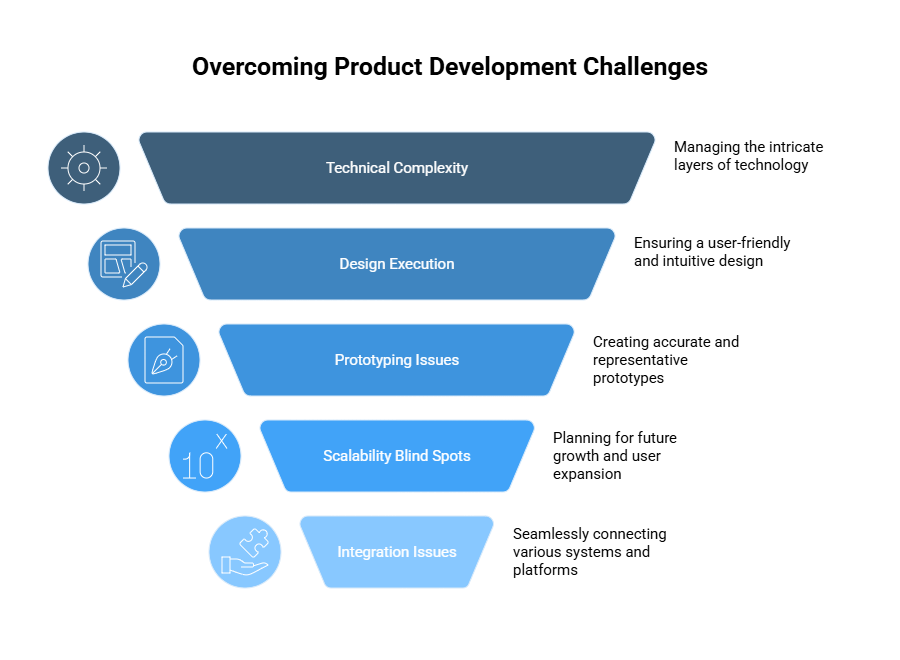
Technical Complexity
This is one of the most critical yet disregarded issues: dealing with the technical complexity of a modern-day product. Software, APIs, databases, user interface, performance requirements, and so forth. These different layers constitute an insurmountable amount of complexity that many teams have to face in one way or another during new product development, especially when speed-to-market is a critical factor.
Case Study: Apple iPhone
The first-ever Apple iPhone would perhaps be the best instance of technical barriers being breached. Apple had to develop a whole new operating system. This touch interface actually worked; a matching set of hardware-software integration worked so smoothly that it fostered innovation and, finally, that ecosystem for the support of future innovation. They concentrated on an agile development approach with very tight iteration cycles coupled with cross-functional collaboration to deliver what was considered impossible by many at that time.
Solution:
Divide complexity into smaller manageable pieces. Adopt scalable architectures, microservices, and modular design wherever possible. Following an agile process, ensure that technical reviews are often enough to prevent worse technical debt. Keeping it simple at the start is never a crime, but scaling wisely is something one should endeavour to achieve.
Poor Design Execution
A technically sound product can fail if it is poorly designed. A clumsy interface, screens that are hard to navigate, or buttons that confuse users will annoy them, even if the mechanisms work perfectly fine. This is one classic example of a product design error and, sadly, one of the challenges in new product development.
Design should never be an afterthought. Users expect good interfaces- a clean look, crisp animations, intuitive interactions, and fast response times. If they are hard to use, users will abandon them even if a technical solution is available.
Solution:
Build UX/UI design from day one. Use wireframes, user flows, and clickable prototypes to validate experiences prior to complete development. Conduct usability testing early and often. Excellent design makes using your product feel seamless and instills trust well before the first transaction ever occurs.
Prototyping Issues
Prototypes help to bring forth an idea, but if done incorrectly, they can mislead teams. Many early-stage products fail because the prototype made too many promises or was not an accurate representation of the final version. This is a somewhat subtle yet quite serious problem that new product development encounters- a factor that affects both money planning and internal team alignment.
Case Study-Superhuman
Superhumans did not go forth with full-fledged development right away. Instead, the team gradually shaped the email client using iterative prototyping and regular user feedback. Every feature was tested before it became part of the final product, allowing them to build a truly personalized experience by avoiding false assumptions.
Solution:
Prototypes are for testing concepts and are not meant to impress stakeholders. They should remain low-fidelity, with a focus on workflows and usability. Key features and flows should then be validated with actual users before moving on to complete design and development. A good prototype saves time and reduces the risk of developing what really matters.
Scalability Blind Spots
Products are designed without considering the possibility of future growth. Building something for a hundred users is easy, but what about 100,000 users? Performance, security, and user experience issues pop up if the architecture cannot scale in time. This hidden long-term risk then presents itself later in development and hits hard.
Solution:
Plan to scale right from the beginning. Leverage cloud-native infrastructure and scalable components. Think more than just MVP; design with future strain points on your system in mind. Scaling is very much about traffic contention but also about maintaining the quality of experience while growing.
Integration Issues
Today’s products rarely go solo. APIs, payment gateways, CRM, analytics, and third-party platforms-all form a tech puzzle. Integration issues may slow down progress, introduce bugs, or create inconsistencies among systems, conversely increasing challenges in new product development.
Solution:
Standardized APIs, version control, and documentation should be considered. Conduct integration testing early. Integration cannot be treated as afterthoughts, for, in many cases, they hold your entire user experience together.
Inadequate Testing
The hurried launching times often see software testing massively compressed or, worse, altogether skipped. This case is also one of the most expensive product development pitfalls. The flaws or broken features stand as a first impression. Skipping testing as a shortcut will quickly erode trust.
Users will never forgive you for their product crashing, lagging, or losing data. Once the reviews pour down on your software, it would be of no help to do fixes.
Solution:
Consider testing part of your culture. Automate if possible: unit testing, integration testing, and regression testing should be part of your CI/CD pipeline. Meanwhile, manual QA serves best for exploratory and usability testing. Consider expensive fixes.
Overengineering
Other adverse challenges in new product development are to try to do more than is necessary. Team members overengineer features the users never asked for, imposing unnecessary complexity and thus slowing development. Often, these misconceptions arise from assumptions rather than validation, along with unclear requirements, misaligned stakeholder expectations, poor prioritization of features, inadequate market research, lack of cross-team collaboration, and the pressure to deliver speed over quality.
The solution:
Focus on the core user needs. The 80/20 approach: what 20% of features give 80% of the total value? Build those first, and then worry about extra features after everything else is working flawlessly.
Technical Deb
Scaling is the premise of a vantage point where initial shortcuts result in painful losses much later. Quick fixes and poor documentation, as well as all sloppy codebases, manifest into technical debts that exacerbate new product development, thus causing a drag on progress and really demoralizing for the teams.
Solution
Address technical debt in short sprints. Set aside some time during every sprint to either refactor code or documentation. The inability to track debt just as any other item in the backlog leads to disaster; one would wish it just disappeared by itself, but the gloomy truth is that it makes scaling a myth.
Lack of Design-System Thinking
Inconsistencies in visual language, components, or interaction patterns make products feel very disjointed. Such discrepancies are highly frustrating for users and bring inefficiencies to the design and engineering teams. This is one of the challenges in new product development, especially for SaaS and cross-platform products.
Solution:
Build and maintain a design system. Shared libraries, standard components, and nomenclature must be put into use. These help cut down reworks, improve usability, and speed up further iterations of the product.
Misaligned Tech and Business Goals
Without the alignment of the technical teams and business leaders, products are prone now and then to either technical overreach or to fall short of their market goals. This misalignment becomes a part of strategic challenges in new product development and thereby creates tension, delays, or missed targets.
Solution:
Ensure federal rituals are in sync across engineering, products, design, and marketing. Translate business outcomes into technical requirements. Parlay timely trade-offs and priorities with transparency so all may work toward the same result.
Why Solving These Challenges Matters?
Early warning signs in the product development process could translate to colossal costs, as any slight misstep that may have caused minor hiccups in the schedule or otherwise deviating from customer expectations could eventually escalate into larger product failures. Therefore, knowing about and working through geographically typical constraints is not only a good thing to consider but an absolute must to truly shrink product development failures and thus ensure product-market sustenance and growth in the long term.
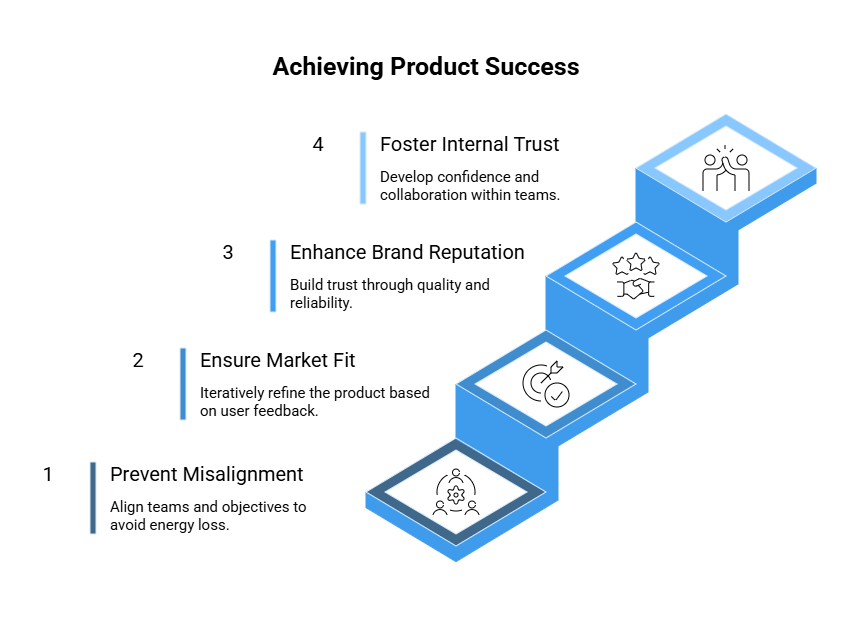
Prevents Product Development Failures Due to Misalignment
Misalignment across teams, unclear objectives, and lack of fundamental understanding of the user are enormous sinks of energy, lost opportunities, and underperforming products. These aren’t just isolated mistakes but systemic risks that, if ignored, tend to result in product development failures. Whether it is an excellent idea that is poorly executed and made to plod or a perfectly built product that nobody needs, accept that time, resources, and market trust are lost.
Addressing these challenges consequently confirms that all teams -engineering, marketing, design, and leadership- are aligned to a single vision rooted in real-world evidence and validation from end-users.
Increases Chances of Product Market Fit
Product-market fit is the plan of any new product. But that’s not something that can happen by accident. A structured and iterative approach is required: one that keeps a constant loop of user feedback, agile thinking, and thoughtful prioritization. The only way to get that alignment of what you’re building with what the market actually wants is by constantly solving the underlying problems, especially those to do with knowing customer wants, pricing, testing, and promotion.
Companies like Superhuman are good examples of this. They didn’t blast the market with a vast feature set all at once. They refined the product continuously by way of feedback loops and slowly but gradually created a product that users didn’t like; they loved it. This deep focus on product-market fit couldn’t exist without tackling fundamental development problems in the early stages.
Improves Brand Reputation and ROI
Each launch builds more trust. Customers notice when a product is intuitive, reliable, and solves their problem. They notice equally once it crashes on them, befuddles them, or frustrates them. Every product development strategy must put quality first-not just because it feels good but because it’s retention, referral, and revenue-influencing.
An example of a company winning on brand reputation despite challenges in new product development delivery is Apple. Apple did not just innovate on the technical side but also showed an exceptional obsession with execution. The original iPhone was one of the most complex technologies ever developed, yet Apple defined the market through a near-perfect integration of design, technology, and process. Such a reputation is built over time and begins with the choice to tackle complex problems that others prefer to avoid.
Builds Internal Trust and Confidence in the Team
Having firmly dealt with the challenges surrounding product development sets the internal organization in credibility. When cross-functional teams are able to witness that they have clear goals, that delivery is indeed fair and constant, and that customer feedback is both strong and valid, they begin to trust and believe in themselves more. Embarking on this road results in process improvement makes collaboration easier, and starts the momentum to grow.
Take Airbnb, for example, aligning its product development strategy with real needs and gaps in the market; it hadn’t just launched a product; it had built a global platform that changed the industry.
How Product Development Services Can Help?
This is one of the extremely complex challenges in new product development requiring, of course, a great idea and goodwill from the team. Further conditions include structured execution, domain-specific knowledge, and an ability to cope with shifting market and technical areas. For many companies, the lipid that comes from working alongside specialized product strategy consulting is what transforms a stalled idea into a market launch.
Whether your goal is to present a new digital product to the market, modernize an aged system, or test an up-and-coming idea, external product development partners will facilitate your work at every stage of the journey.
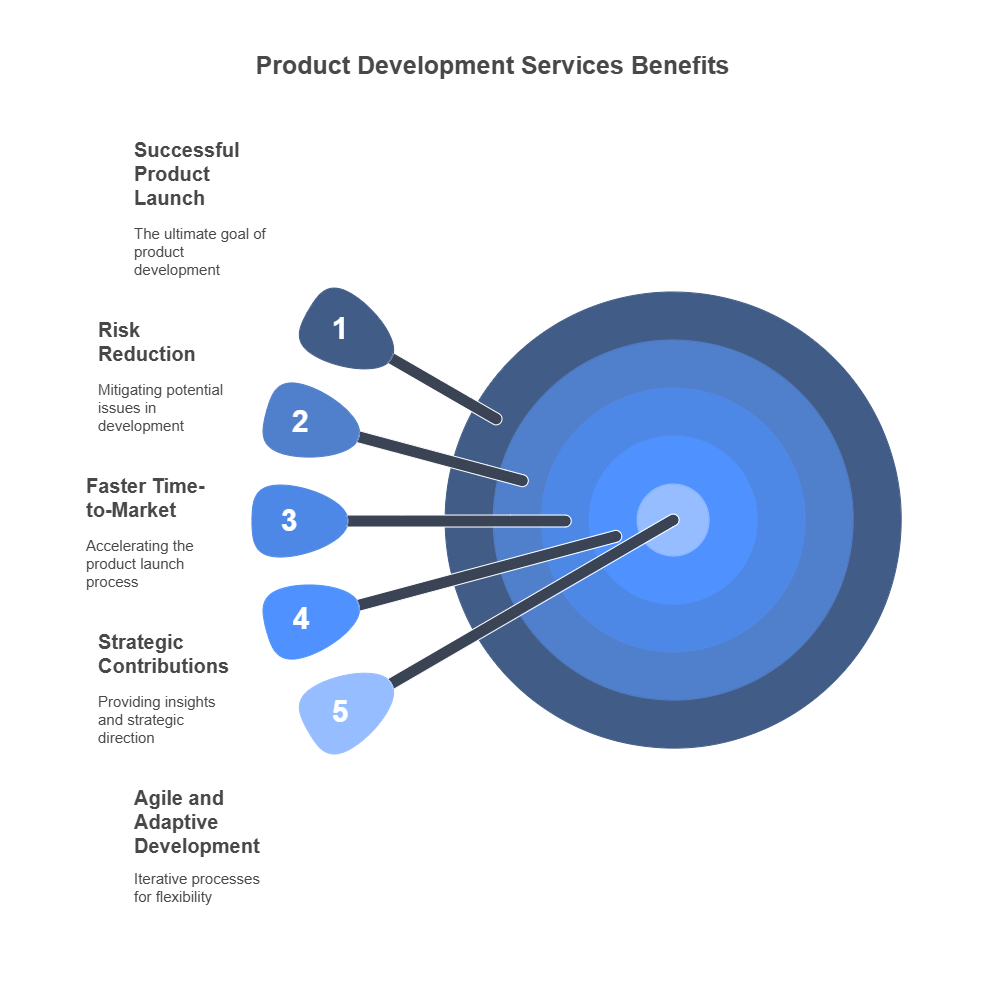
Complete Lifecycle Vendors
Generally, bespoke product solutions range from the very first inception of ideas to research, product design, development and testing, and go-to-market preparation. Their teams of cross-functional specialists contain product strategists, product designers, developers, and project managers who are familiar with industry standards and best practices.
This integrated approach really does help an organization overcome one of the primary challenges in new product development organizations with siloed teams and disjointed processes. Rather than having to deal with fragmented handoffs or unclear responsibilities, these companies actually benefit from a single end-to-end delivery model.
Developing in an Agile and Adaptive Manner
Internal teams oftentimes are crippled by outdated processes that leave no possibility for iteration or user feedback. Most software product development are based on agile frameworks, which refrain from holding on to the lifecycle for long. During sprint cycles, quick validation phases and course-correcting are allowed should conditions in the market or customers’ needs change.
Consequently, using iterative sprint frameworks during product creation prevents the company from becoming a victim of issues such as scope creep, misaligned deliverables late in development, or missed deadlines. Such an agile model will particularly tackle the ongoing challenges in new product development: keeping track of progress in accordance with insights from the real world.
Another Point of View and Strategic Contributions
An experienced product development partner has more to offer than technical skills; he also maintains an external perspective on market trends, user behaviour, competitor strategies, etc. This external insight could prove very useful when identifying blind spots or validating assumptions that might otherwise impede a project’s success.
In many situations, these services also assist the formulation of the product development strategy itself, whereby a company would prioritize what features to focus on, the value proposition to promote, and the key aspects that are important to the user. This strategic vertical alignment is, therefore, the antidote to costly mistakes in attaining product-market fit.
Faster Time-to-Market
Time is of the essence in racing corporations. Yet haste without structure invariably compromises quality, builds technical debt, or results in a poor user experience. A mature development pipeline, time-tested frameworks, and a pool of skilled talent ensure that partner new product development offers reduced time-to-market without compromising standards.
Through flexible engagement models (dedicated teams, short-term sprints, or on-demand expertise), these partners thus offer companies the flexibility to act quickly while having confidence in delivery.
Risk reduction and a maximized ROI
A new product always comes with some risk. On the way to mitigating this risk, however, the exemplary product development service will embed proven processes, validated methodologies, and quality assurance in its approach. This flexibly structured product development process, replete with user feedback and far technical rigor, puts companies in the best possible position to respond to any challenges in new product development and turn their ideas into real solutions that can grow.
Let’s Build Your Product from Start to Success
Evolving Trends That Influence Challenges in New Product Development
Challenges in new product development are anything but stable and keep morphing with shifts in consumer behavior, new technologies, and changing organizational landscapes. Even the best of teams, holding well-defined roadmaps with a mature product development process, may fail if they are not philosophical enough to anticipate and adjust to these trends. Here are some key forces shaping new product challenge landscapes.
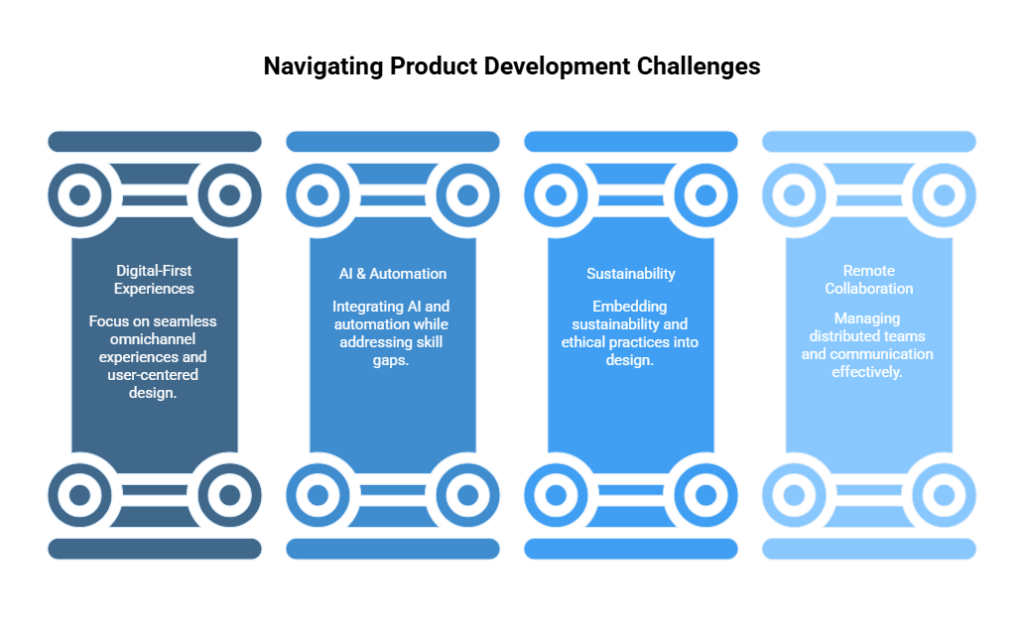
Shift toward Attention to Digital-First Experiences
Today, consumers expect a seamless omnichannel experience. So, while it can be said that an app is your bank or a watch inscribed with your name is your product, the very digital interface is pivotal to the user’s delight. In this way, challenges in new product development get even bigger and magnified by pushing it towards creating pleasant, easy, and the same experience from one platform to the other under time constraints.
To address this, companies are increasingly relying on user-centered design, cross-functional prototyping, and iterative testing. This can help eliminate the early misalignment between engineering and UX design.
Rise of AI, Automation & Low-Code
Artificial intelligence and low-code platforms are bringing further disruption into the development workflows while adding yet another layer of complexity. Most product teams lack the skills in-house to exploit these technologies fully. This emerges as one of the challenges in new product development as the pressure to innovate clashes with the shortage of requisite skills and steep learning curve.
A resolution may be to upskill internal teams or outsource to product development service providers with niche capabilities in areas like AI modelling, API orchestration, and cloud-native architecture.
Sustainability and Ethical Design
Consumers and regulators alike demand products designed to be sustainable and ethical. Thus, for any modern organization, sustainability now has to be embedded into each design and decision; it is no longer optional. However, doing so without adding cost or complexity is a massive challenge in new product development, especially when the development process was not designed for it from the outset.
Companies such as Patagonia and Tesla have embraced this challenge by giving thought to life cycle thinking and ethical sourcing early in their product development. Their success story only reiterates the fact that sustainability should never be an afterthought in product development but an integral part.
Remote Work and Global Collaboration
Distributed teams are now normal. Remote working provides flexibility and access to a worldwide talent pool but widens the chasm in communication and alignment. These miscommunications and delays, in turn, escalate challenges in new product development, particularly during design handoffs, sprint planning, and user-testing phases.
The remedy? An antidote would be to standardize collaboration using cloud-based tools, shared documentation, and synchronous-asynchronous workflows. Successful companies would also layer agile ceremonies and feedback loops to provide visibility across time zones.
Conclusion
Successfully navigating the complexities of modern product development requires more than just innovation; it demands a clear strategy, cross-functional alignment, and continuous iteration. Addressing these common product development bottlenecks pro-actively helps reduce risk, increase efficiency, and realize products that fit the market.
This approach supports stronger results, starting from early-stage planning to the core set of pre-launch activities and, finally, post-launch optimization.
When organizations set up a rock-solid strategy and surround themselves with expert product development services, they stand a much better chance at making a lasting product-market fit and keeping a must-wins mark in an environment that is ever fast-paced and demanding.
If you want to surpass new product development challenges, visit us here.
Frequently Asked Questions
1. What are the biggest challenges in new product development?
The significant challenges happen to be an unclear scope, changing customer needs, a tight timeline, technical complexity, and scarce resources. Combining these hurdles would hamper a project being completed on time, within budget, or meeting an end user’s expectation.
2. How can companies avoid common pitfalls in product development?
Since pitfalls appear hard to avoid, the key to steering away from them is precise planning, cross-functional collaboration, and continuous user feedback inputs. Agile and fast prototyping, along with short lists of trusted partners in product development services, are good contributors to making a stable journey away from trouble.
3. Why is product-market fit so hard to achieve?
Achieving product-market fit requires an in-depth understanding of customers, testing assumptions in the early stages, and iterating with honest feedback. Much of the time, teams side-step the actual needs of the market in terms of features, make gross errors in pricing or develop weak go-to-market strategies. These are just a few of the most essential causes behind product development failures.
4. What role does strategy play in overcoming product development challenges?
A strong product development strategy provides the most significant opportunity for alignment between trade-offs occurring among business objectives, customer needs, and the actual implementation of a product. It makes decisions easy, reduces wasted effort, and maximizes team engagement on things that matter most.
5. How do product development services help solve any challenge in new product development process?
With such services incorporated into the product lifecycle, technical expertise, agile processes, and structured workflows were used in the past to overcome the hindrances of the product development process. They made development faster, cheaper, and quicker to market with little to no heavy toll on the internal environment.



